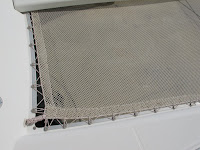The original trampoline on LUX had seen better days. The grommets were pulling out of the material that around the edge and the lines that held the tramp in place were chafing on the grommets and squeaking loudly when we stepped on the tramp. Parts of it had ripped right in front of each of the hatches, which we repaired by adding a small patch piece and threading small line through the holes.
 |
| Lagoon Netting Tramp |
 |
| Lagoon Tramp Edge Detail |
We had been looking at other tramps and rather liked the designs that used a bolt rope around the perimeter. A 40 ft Lagoon at one boat yard had a netting tramp that was done this way and we took some photos.
 |
| Web Overlap Stitching |
Carol ordered replacement tramp material from Manart-Hirsch, a wholesale supplier of boat canvas materials. We decided on the same material that was originally on LUX, a webbing that is 1/4 inch strips on 1/2 inch centers. It doesn’t let water and air through as readily as the netting that we’ve seen on other boats (like the Lagoon). But it feels a lot better under foot or lying on it. If we were sailing in waters where we would have the possibility of green water on the tramp, then we’d have considered the netting.
The material doesn’t come in a width that can do the tramp in one piece, so Carol and Mike thought about how to best couple two pieces together. The final result was to use 3M 5200 to glue the two pieces together, then stitch it. A strip of plastic was laid down first so the adhesive wouldn’t make a mess on our work area. The two pieces were carefully aligned with the 5200 adhesive, then more plastic was put on top. Boards topped with with bricks were used to press the two pieces together. Then we waited several days for the adhesive to set. The adhesive made stitching a lot easier. The Consew industrial sewing machine was loaded with Gortex thread, which doesn’t deteriorate from UV light. This means that we won’t have to restitch it after a few years. Carol stitched each of the seven webs that overlapped (see the red arrows at the top and bottom row of stitching).
 |
| Tramp Edging with Stamoid binding |
The tramp was folded over along the edge, using an outline we had made from the old tramp. The outline also matched the plans that we found online. The two sides bow slightly in the plans, but there is so little curve that the tramp can be built with straight sides. The edge overlap is covered with Stamoid cloth and several rows of stitching.
 |
| Tramp Edge Detail, Top Side |
The tramp was tied to the bows and beam with 1/4 inch dacron line. It is important that the stitching have two lines at each corner and in the middle of each side so that if any single line breaks, the tramp integrity keeps crew members aboard.
 |
| Completed Tramp |
An unexpected benefit is that the tramp is much quieter than with the grommets. It is more stable and less bouncy. This was another great sewing project by Carol.
